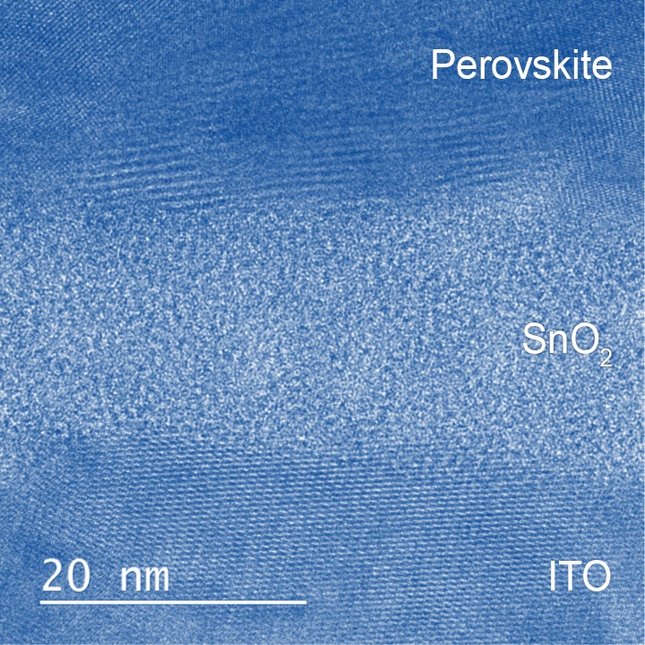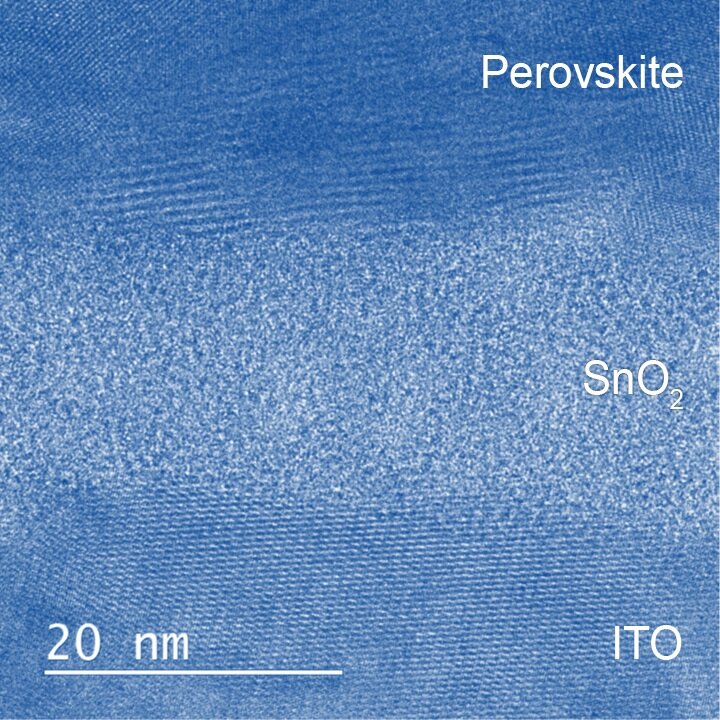
With the aim to lower the price of solar electricity, our research focuses on the development of high-efficiency solar cells that can be produced at an industrial scale and at acceptable cost.
Nanolayers for crystalline silicon solar cells
Crystalline silicon (c-Si) solar cells consist of a crystalline silicon wafer which absorbs the sunlight, on which typically various functional thin films are deposited. Our research focusses on both heterojunction and homojunction c-Si solar cells. An example of a typical silicon heterojunction solar cell is shown below. In both types of solar cells, most of the interesting physics occurs at the interfaces between the various layers since the wafer bulk quality is very high whereas the thin films are very thin (<100 nm). The solar cell has truly become an interface device, where the deposition of thin films is becoming more and more important in the quest for reaching the thermodynamic efficiency limit.
In c-Si solar cells, thin films can fulfil several roles:
• Anti-reflection coatings (ARCs) which minimize the amount of light reflected by the (otherwise very reflective) silicon wafer. E.g. a-SiNx:H, TiO2, and ZnO
• Transparent conductive oxides (TCOs) which are needed at the front of certain types of cells to laterally conduct charge to the front metal contacts. Often the TCO is also an ARC. E.g. doped ZnO and In2O3
• Passivation layers which are needed to minimize electrical losses at the silicon surface by reducing the density of electronic defect states. E.g. Al2O3, SiO2, amorphous silicon (a-Si:H), a-SiNx:H
Within the Plasma & Materials Processing (PMP) group we work on all of these roles thin films can have in c-Si solar cells. Our research consists of both experimental investigations and theoretical modelling of the solar cell device properties.
Nanolayers for thin film solar cells
The PMP group has a long history in silicon thin film development ranging from Expanding Thermal Plasma Chemical Vapour Deposition (ETP-CVD) to Plasma Enhanced Chemical Vapour Deposition (PECVD) techniques enabling high-rate processing of high-quality materials feasible for industry. Two common materials for film silicon solar cells are intrinsic amorphous silicon (a-Si:H) and nanocrystalline silicon (nc-Si:H), which function as light-absorbing layers. Both of these materials can be deposited by the same plasma deposition techniques, where the crystalline fraction can be tuned by controlling the plasma properties. The different microstructure of the silicon thin films results in different optical and electrical properties, so these two materials can be combined in a single solar cell (a so-called tandem cell) in such a way that enhanced light absorption can be achieved.
In our research, we study the growth of these silicon thin films by investigating the material itself; the plasma that is used to deposit the material; and the interactions between the plasma and the material surface. In addition to intrinsic absorber layer characterization, these properties are studied for solar cell configurations, including p- or n-type window layers. Plasma processes can considerably impact the interface properties and therefore reduce/improve the solar cell performance.
Furthermore, the introduction of new concepts such as nano-imprint lithography textured glass, requires a thorough understanding of thin film development and process control. We study, for example, how the rough surface influences the formation of voids and cracks in the layers, as these defects lead to electrical losses.
With the aim to lower the price of solar electricity, our research focuses on the development of high-efficiency solar cells that can be produced at an industrial scale and at acceptable cost.
Nanolayers for crystalline silicon solar cells
Crystalline silicon (c-Si) solar cells consist of a crystalline silicon wafer which absorbs the sunlight, on which typically various functional thin films are deposited. Our research focusses on both heterojunction and homojunction c-Si solar cells. An example of a typical silicon heterojunction solar cell is shown below. In both types of solar cells, most of the interesting physics occurs at the interfaces between the various layers since the wafer bulk quality is very high whereas the thin films are very thin (<100 nm). The solar cell has truly become an interface device, where the deposition of thin films is becoming more and more important in the quest for reaching the thermodynamic efficiency limit.
In c-Si solar cells, thin films can fulfil several roles:
• Anti-reflection coatings (ARCs) which minimize the amount of light reflected by the (otherwise very reflective) silicon wafer. E.g. a-SiNx:H, TiO2, and ZnO
• Transparent conductive oxides (TCOs) which are needed at the front of certain types of cells to laterally conduct charge to the front metal contacts. Often the TCO is also an ARC. E.g. doped ZnO and In2O3
• Passivation layers which are needed to minimize electrical losses at the silicon surface by reducing the density of electronic defect states. E.g. Al2O3, SiO2, amorphous silicon (a-Si:H), a-SiNx:H
Within the Plasma & Materials Processing (PMP) group we work on all of these roles thin films can have in c-Si solar cells. Our research consists of both experimental investigations and theoretical modelling of the solar cell device properties.
Nanolayers for thin film solar cells
The PMP group has a long history in silicon thin film development ranging from Expanding Thermal Plasma Chemical Vapour Deposition (ETP-CVD) to Plasma Enhanced Chemical Vapour Deposition (PECVD) techniques enabling high-rate processing of high-quality materials feasible for industry. Two common materials for film silicon solar cells are intrinsic amorphous silicon (a-Si:H) and nanocrystalline silicon (nc-Si:H), which function as light-absorbing layers. Both of these materials can be deposited by the same plasma deposition techniques, where the crystalline fraction can be tuned by controlling the plasma properties. The different microstructure of the silicon thin films results in different optical and electrical properties, so these two materials can be combined in a single solar cell (a so-called tandem cell) in such a way that enhanced light absorption can be achieved.
In our research, we study the growth of these silicon thin films by investigating the material itself; the plasma that is used to deposit the material; and the interactions between the plasma and the material surface. In addition to intrinsic absorber layer characterization, these properties are studied for solar cell configurations, including p- or n-type window layers. Plasma processes can considerably impact the interface properties and therefore reduce/improve the solar cell performance.
Furthermore, the introduction of new concepts such as nano-imprint lithography textured glass, requires a thorough understanding of thin film development and process control. We study, for example, how the rough surface influences the formation of voids and cracks in the layers, as these defects lead to electrical losses.
